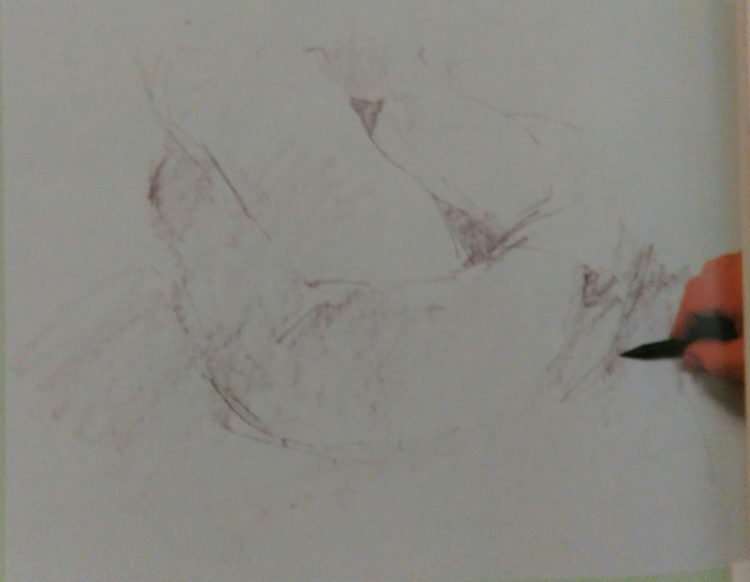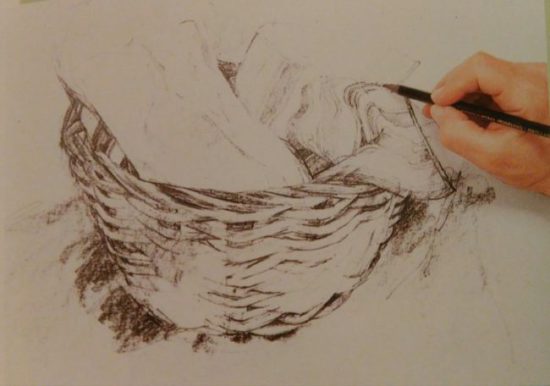Pure graphite, the same graphite you can find in graphite pencils can also be purchased in the form of graphite sticks. Graphite sticks can be soft or hard and can be in the form of a round pencil or hexagonal stick which is used for covering large surfaces while drawing. They look like ordinary pencils but are much heavier because they consist of melted and pressed graphite.
Graphite is a very expressive medium and if you know how to use graphite sticks you can create really good drawings with them and have a lot of fun doing it since graphite simply challenges you to use relaxed daring moves. This is an excellent medium for beginners because it simply encourages the artist to look at the composition rather than focus on the details.
It glides on the surface you are drawing on lightly letting you cover big surfaces very easy. If you apply light pressure to the surface the graphite will leave a silky trail on the paper letting the texture of the paper be seen through it. If you apply more pressure you will get dark strong trails.
You can get many different effects with graphite sticks depending on whether you are using the tip, the side of the sharpened tip or the flat side of the entire stick.
Study Of Textures
The best still life models are more often the ones that you come up with
For this drawing, you will need the following:
- One sheet of good quality natron paper
- Round graphite sticks numbers 4B and 6B
- Kneaded eraser
- Spray fixative
Sketching
Place the paper on the drawing board and secure it with pins or tape. Make a light sketch of the entire composition using graphite stick number 6B. Make sure that composition is filling the entire page.
Draw relaxed, from the wrist using the side of the graphite stick to cover the big surface of the shadow. Leave the drawing pale and incomplete so you can gradually build it as you draw.
This will help you make the composition balanced and proportional. In all your artwork always try to work on all the parts of your creation simultaneously adding details and elements as you go.
Adding The Details
Now you can start adding the details to your drawing constantly making sure that the proportion and shapes are accurate.
Work on the basket using graphite stick number 4B to draw darker, stronger lines. Notice how the basket gets darker as it leans forward in space.
Shape one and of the kneaded eraser to a thin point and use it to erase little areas on the basket where the sun illuminates the weavings on it.
As the texture of the basket is very complicated you need to simplify it a little bit in order to draw it easier.
Carefully observe its main structure. With relaxed moves draw some of the vertical twigs first then add horizontal ones that bend around them. Leave the drawing very light at this stage. You can ad richer darker tones later.
Continue working on the weavings of the basket using the tip of graphite stick to ad shadows. Have in mind the ratio of light and shade on the basket and use thinner and thicker lines to depict matching tones and shadows.
Determine twisted rim of the basket blurring some of the lines to create the shades and light areas.
Use the side of graphite stick number 6B to darken the shade that the basket is creating to give it some heaviness.
With the tip of graphite stick, number 4B draw striped texture of the napkin carefully following the contour of wrinkles and ridges of the fabric.
Fill the stripes with fine lines and hatching. Sharpen the sticks more often to have the tip of graphite stick constantly pointed.
Start working on the wrinkled paper bag. First, point out the rough edges with precise lines and then using the side of the graphite stick mark soft ridges and shadows.
Finishing Touches
Work on the weavings of the basket giving more strength to already built
Notice how the twigs look closer together and darker as the basket bents backwards and try to express that on your drawing.
Finish the basket shading each individual twig with thin hatching using sharpened graphite stick number 4B. Ad dark tones between the twigs to give the basket depth and shape.
Use crosshatching in the areas where the basket bends in shade in the background. Leave white areas on the twigs to create the impression of illumination or draw them using the pointed end of the kneaded eraser.
Complete the drawing with several pale shadows around and behind the basket using the side of the graphite stick number 4B. This shadow is supposed to be pale, drawn with relaxed moves in order to support and point out the main object.
After adding the finishing touches and completing your drawing use spray fixative to preserve it. Since the graphite smears very easily make sure you keep the hand your drawing with away from the surface of your drawing or if that doesn’t work for you use a piece of clean paper placed between your hand and the drawing.
You will need to add at least two layers of fixative on your drawing. Make sure you spray it from the distance so you don’t smear it and also make sure the first layer of the fixative is completely dry to the touch before adding the next layer on top of it.
This is one of many ways of using graphite sticks. If you have any questions regarding the subject feel free to leave them below and I will be more than happy to answer them.








0 Comments